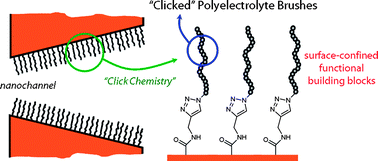A facile route for the preparation of azide-terminated polymers. “Clicking” polyelectrolyte brushes on planar surfaces and nanochannels
Abstract
In this work we describe the facile preparation of azide-terminated

* Corresponding authors
a Max-Planck-Institut für Polymerforschung, Ackermannweg 10, D-55128 Mainz, Germany
b Darmstadt University of Technology, Department of Materials Science, Petersenstraße 23, D-64287 Darmstadt, Germany
c GSI Helmholtzzentrum für Schwerionenforschung GmbH, Planckstr. 1, Darmstadt, Germamy
d Austrian Institute of Technology, Donau-City-Straße 1, 1220 Vienna, Austria
e
Instituto de Investigaciones Fisicoquímicas Teóricas y Aplicadas (INIFTA), Universidad Nacional de La Plata – CONICET, CC 16 Suc. 4, La Plata, Argentina
E-mail:
azzaroni@inifta.unlp.edu.ar
Web: http://softmatter.quimica.unlp.edu.ar
In this work we describe the facile preparation of azide-terminated

 Please wait while we load your content...
Something went wrong. Try again?
Please wait while we load your content...
Something went wrong. Try again?
B. Yameen, M. Ali, M. Álvarez, R. Neumann, W. Ensinger, W. Knoll and O. Azzaroni, Polym. Chem., 2010, 1, 183 DOI: 10.1039/B9PY00201D
To request permission to reproduce material from this article, please go to the Copyright Clearance Center request page.
If you are an author contributing to an RSC publication, you do not need to request permission provided correct acknowledgement is given.
If you are the author of this article, you do not need to request permission to reproduce figures and diagrams provided correct acknowledgement is given. If you want to reproduce the whole article in a third-party publication (excluding your thesis/dissertation for which permission is not required) please go to the Copyright Clearance Center request page.
Read more about how to correctly acknowledge RSC content.
 Fetching data from CrossRef.
Fetching data from CrossRef.
This may take some time to load.
Loading related content
